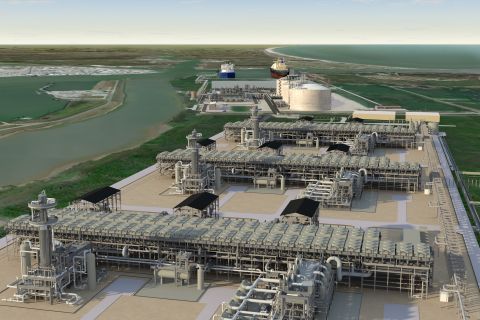
Panelists representing the oil, wind, solar and power sectors seem to agree that private sector financing will not be enough to enable the energy transition. (Source: Shutterstock.com)
When it comes to the energy transition and reducing global emissions, the oil industry has something to offer. The problem is some people don’t want to talk, according to Vicki Hollub, president and CEO of Occidental Petroleum Corp.
Occidental, a leading producer in top shale plays in the Permian and Denver-Julesburg basins, also has more than 40 years’ worth of experience in handling CO2 including for EOR. It is through these core competencies around carbon management that Occidental aims not only to reduce its own emissions but provide impactful decarbonization solutions across industries, Hollub said speaking on a panel during a recent energy and economy conference hosted by the federal reserve banks of Dallas and Kansas City.
“Our strategy is to convert our use of organic CO2 to anthropogenic CO2 and atmospheric CO2, and to do that not just in our operations, but to start doing it around the world to help the hard-to-decarbonize industries have some way to get net negative as a corporation and to get net negative fuels to use,” she said. “It’s absolutely necessary to remove CO2 from the atmosphere to cap global warming at one and a half degrees.”
However, getting in on cross-sector conversations to help devise achievable plans is difficult.
“Most people don’t want to be in the room talking to an oil and gas company CEO,” Hollub said, noting the need for collaboration across different sectors. “A lot of companies are doing this in a vacuum and trying to help the world get there, and the world cannot get there without us. So, our challenge is to get people to talk to us.”
Occidental’s Expertise
Occidental, which is part of an alliance called CCS+ Initiative targeting carbon removal efforts with a focus on carbon accounting, has been scaling up its own carbon-capture business. Earlier this month, Occidental subsidiary Oxy Low Carbon Ventures (OLCV) awarded a services contract to Worley for commercial-scale facility in British Columbia that will capture CO2 from the atmosphere using Carbon Engineering’s Direct Air Capture and AIR TO FUELS technologies. OLCV subsidiary 1PointFive is also developing a direct air capture facility in the U.S. Permian Basin that is expected to capture 1 million metric tons of atmospheric CO2 for permanent storage when complete.
“We expect that because of the difficulty of decarbonizing maritime and aviation that a lot of direct air capture will need to be built,” Hollub said. “What we’re concerned about is that there’s 50% more CO2 in the atmosphere today than there was in pre-industrial times. So, you have to have direct air capture. You can’t just retrofit industry to capture the emissions going forward. Even if you did that, we would still need to build direct air capture to get the CO2 out of the atmosphere. It’s going to happen. We’re committed to do it.”
Support from regulators, including providing a direct pay option for the 45Q tax credit, could help incentivize and speed up development, she added.
“The more we accelerate it the sooner we’ll be [in] attacking the problem,” Hollub said. “We expect that this will be a $3-$5 trillion industry when you when you take into account all of carbon capture and sequestration and the equipment required for it.”
Funding the Transition
Hollub was joined on the panel by the heads of wind blade manufacturer TPI Composites, residential solar company Sunnova Energy Corp. and Omaha Public Power District, a public electric utility in Nebraska.
The conversation took place as the world’s energy providers carry out emission reductions plans, aiming to hit net-zero, utilizing technology and low-carbon solutions.
For oil companies, the pressure is on to meet growing global energy needs and turn profits without harming the environment or closing doors to capital. A lot of hope is also resting on renewables such as wind and solar. Regardless of how much of energy supply mix each occupies, developers of all forms of energy are searching for opportunity in a sea of challenges.
Panelists seem to agree that private sector financing will not be enough to enable the energy transition.
“The energy transition does not happen without some incentives from the government to build the technology,” Hollub said. “If we’re going to rely on the private sector doing it when we can’t even talk across sectors, it’s not going to happen. As a world, we’re in big trouble.”
Taking a strong, balanced portfolio approach is key, added Steve Lockard, board chairman for TPI Composites, pointing out incentives are needed to accelerate deployment of technologies like direct air capture as well as hydrogen, transmission infrastructure and storage.
“We’ve got to go faster. That’s what really helped wind and solar drive costs down in a big way,” Lockard said. He later added “there’s a lot of private sector capital that wants to be put to work,” supported by incentives.
Private capital won’t come, however, without users on the other end, said Javier Fernandez, president and CEO of Omaha Public Power District, turning back to consumers. At some point, how customers pay their bills could evolve in a way that’s similar to cell phone bills. “We pay one fixed price. Doesn’t matter how much you use, you’re paying for the access to the grid.”
There should also be incentives to encourage more private and public investment, he said, to ensure investors are truly recovering costs required for a more reliable grid.
Trade, Tariff Woes
Like the oil sector, renewables are under pressure to keep costs low and cope with rising prices. While scale has helped drive down costs globally, the current trade and geopolitical environment is adding to inflationary-related pressure, Lockard said.
“Recently, steel prices have doubled; a 25% import duty from China. Resin prices are up. It’s just been difficult,” Lockard said. “But we have had some recent easing on certain commodities. … In the short term, we’re probably going the wrong way from a cost standpoint. But this industry—the wind and solar industry—has just been very disciplined about driving cost out. And I think over the next number of years, we’ll get right back on to a constructive trend.”
The success of wind and solar in the last decade has been driven mainly by economic improvements along with incentives.
“The cost of solar has come down on average 90% levelized cost of energy in the last 12 years and wind roughly 70% or so,” Lockard said, noting it’s competitive with the marginal cost of gas and coal on an unsubsidized basis.
However, the bigger issue for wind and solar buildout, he continued, concerns transmission and RTO planning and integration at higher penetration rates.
“We’re at 10% or so today and growing, but to get to 20, 30, 40% of electricity from renewables, it’s more about getting the grid right and getting the storage and transmission to sync up with the next phase, if you will, of buildout of wind and solar,” Lockard said.
Sunnova Energy Corp. CEO John Berger added forced labor allegations made by the U.S. against the Chinese government has stopped a lot of utility scale solar panels from entering the U.S. from China. Add to this Section 201 tariffs on solar panels—which currently stand at 18% but could drop to zero in February if an extension is not granted—and countervailing duties within Southeast Asia that’s before the International Trade Commerce Committee.
“It’s created chaos where there already was chaos across our supply chain,” Berger said. “If you’re in the utility scale solar industry predominantly buying from China, you’ve got it even worse. … [Plus] There is a growing number of people being laid off on utility scale solar projects because there are no panels, and it’s a little hard to build utility scale solar without any panels.”
The solar sector is also experiencing a shortage of electricians, which Berger said he believes will be a long-term trend given moves toward more electrification.
Another challenge with the energy transition is the consumer piece and its impact on electric grids, according to Fernandez. This involves electric vehicles, residential solar and data centers, which consume lots of electricity.
“It’s that piece that is really making our transition more complicated, but at the same time more exciting,” Fernandez said. “Infrastructure investments are absolutely needed. …. It’s [also] incredibly important for us to have an integrated transmission system across the country, and those are not easy. It requires not only the investment for transmission infrastructure, but coordination with federal entities, crossing states, land permits, integration between RTOs. It’s really, really complicated. I would say that is probably one of the single most important barriers for the energy transition that we will face in the next decade.”
Recommended Reading
Segrist: The LNG Pause and a Big, Dumb Question
2024-04-25 - In trying to understand the White House’s decision to pause LNG export permits and wondering if it’s just a red herring, one big, dumb question must be asked.
Texas LNG Export Plant Signs Additional Offtake Deal With EQT
2024-04-23 - Glenfarne Group LLC's proposed Texas LNG export plant in Brownsville has signed an additional tolling agreement with EQT Corp. to provide natural gas liquefaction services of an additional 1.5 mtpa over 20 years.
US Refiners to Face Tighter Heavy Spreads this Summer TPH
2024-04-22 - Tudor, Pickering, Holt and Co. (TPH) expects fairly tight heavy crude discounts in the U.S. this summer and beyond owing to lower imports of Canadian, Mexican and Venezuelan crudes.
What's Affecting Oil Prices This Week? (April 22, 2024)
2024-04-22 - Stratas Advisors predict that despite geopolitical tensions, the oil supply will not be disrupted, even with the U.S. House of Representatives inserting sanctions on Iran’s oil exports.
Association: Monthly Texas Upstream Jobs Show Most Growth in Decade
2024-04-22 - Since the COVID-19 pandemic, the oil and gas industry has added 39,500 upstream jobs in Texas, with take home pay averaging $124,000 in 2023.





